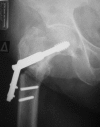Dual lag screw cephalomedullary nail versus the classic sliding hip screw for the stabilization of intertrochanteric fractures. A prospective randomized study
- PMID: 23086659
- PMCID: PMC3482439
- DOI: 10.1007/s11751-012-0146-3
Dual lag screw cephalomedullary nail versus the classic sliding hip screw for the stabilization of intertrochanteric fractures. A prospective randomized study
Abstract
This study is a randomized prospective study comparing two fracture fixation implants, the extramedullary sliding hip screw (SHS) and the dual lag screw cephalomedullary nail, in the treatment of intertrochanteric femoral fractures in the elderly. One hundred and sixty-five patients with low-energy intertrochanteric fractures, classified as AO/OTA 31A, were prospectively included during a 2-year period (2005-2006). Patients were randomized into two groups: group A included 79 hip fractures managed with sliding hip screws and group B included 86 fractures treated with cephalomedullary nails. Delay to surgery, duration of surgery, time of fluoroscopy, total hospital stay, implant-related complications, transfusion requirements, re-operation details, functional recovery, and mortality were recorded. The mean follow-up was 36 months (24-56 months). The mean surgical time was statistically significantly shorter and fluoroscopy time longer for the group B. No intraoperative femoral shaft fractures occurred. There was no statistically significant difference in the functional recovery score, reoperation, and mortality rates between the 2 groups. A new type of complication, the so-called Z-effect phenomenon, was noticed in the cephalomedullary nail group. There are no statistically significant differences between the two techniques in terms of type and rate of complications, functional outcome, reoperation and mortality rates when comparing the SHS and the cephalomedullary nail for low-energy AO/OTA 31A intertrochanteric fractures. Our data do not support recommendations for the use of one implant over the other.
Figures







References
-
- Hornby R, Evans JG, Vardon V. Operative or conservative treatment for trochanteric fractures of the femur: a randomized epidemiological trial in elderly patients. J Bone Jt Surg Br. 1989;71:619–623. - PubMed
LinkOut - more resources
Full Text Sources

